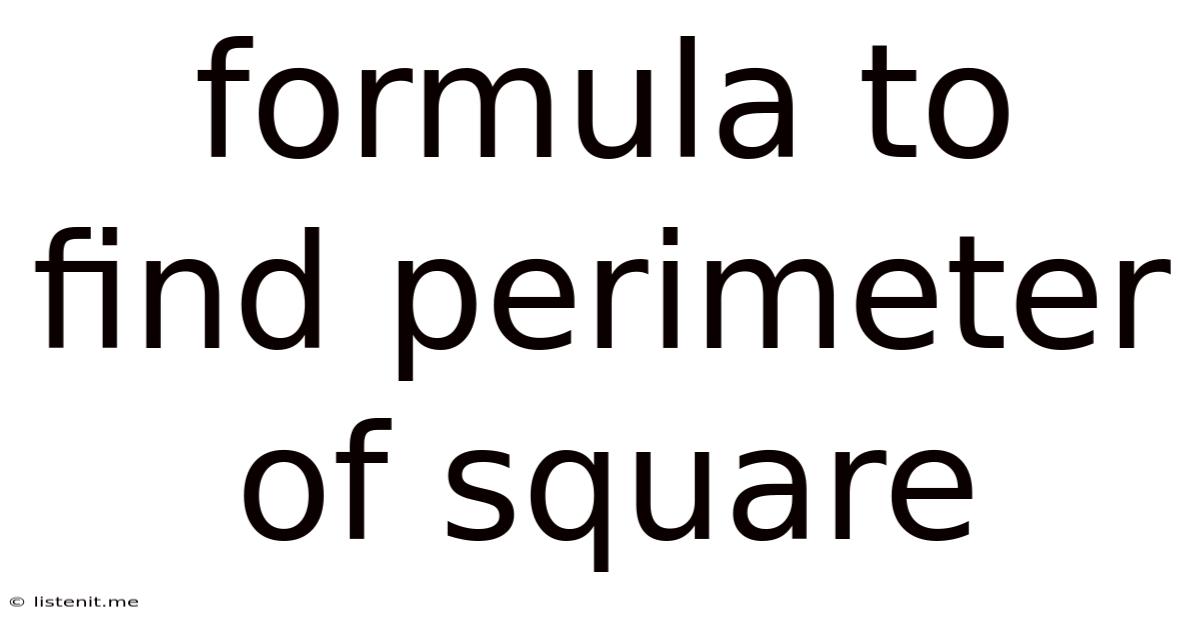Formula To Find Perimeter Of Square
listenit
May 12, 2025 · 4 min read

Table of Contents
The Ultimate Guide to Finding the Perimeter of a Square
The perimeter of a square, a fundamental concept in geometry, is the total distance around its four sides. Understanding how to calculate this seemingly simple measurement is crucial for various applications, from basic construction and design to advanced engineering and computer graphics. This comprehensive guide dives deep into the formula, provides examples, explores related concepts, and offers tips for mastering this essential geometric skill.
Understanding the Square
Before we delve into the perimeter formula, let's solidify our understanding of what a square is. A square is a two-dimensional geometric shape characterized by four equal sides and four right angles (90-degree angles). This unique property of equal sides is the key to simplifying the perimeter calculation. Unlike rectangles or other quadrilaterals, we don't need to measure each side individually.
Key Properties of a Square:
- Four equal sides: This is the defining characteristic of a square.
- Four right angles: Each internal angle measures exactly 90 degrees.
- Opposite sides are parallel: This property is a consequence of the equal sides and right angles.
- Diagonals bisect each other at right angles: The diagonals of a square intersect at a point that divides each diagonal into two equal segments.
The Formula: Simplicity Itself
The simplicity of the square's structure translates to a straightforward perimeter formula. Since all four sides are equal, we only need to know the length of one side to calculate the total perimeter. The formula is:
Perimeter = 4 * side length
Where:
- Perimeter: The total distance around the square.
- Side length: The length of any one side of the square.
Understanding the Formula Intuitively
Imagine walking around the square. You'd walk the length of one side, then another, and another, and finally the last. Since each side is the same length, you're essentially walking four times the length of a single side. This intuitive understanding perfectly matches the formula.
Examples: Putting the Formula into Practice
Let's illustrate the formula with a few examples, progressing from simple to more complex scenarios:
Example 1: The Basic Square
A square has a side length of 5 cm. To find its perimeter, we apply the formula:
Perimeter = 4 * 5 cm = 20 cm
Therefore, the perimeter of the square is 20 cm.
Example 2: A Larger Square
Consider a square playground with a side length of 12 meters. Using the formula:
Perimeter = 4 * 12 m = 48 m
The perimeter of the playground is 48 meters.
Example 3: Working Backwards
Sometimes, you might know the perimeter and need to find the side length. Let's say a square has a perimeter of 36 inches. To find the side length, we rearrange the formula:
Side length = Perimeter / 4 = 36 inches / 4 = 9 inches
Each side of the square is 9 inches long.
Example 4: Real-World Application – Framing a Picture
You need to frame a square picture with a side length of 8 inches. How much framing material do you need?
Perimeter = 4 * 8 inches = 32 inches
You need 32 inches of framing material.
Beyond the Basics: Exploring Related Concepts
While the perimeter formula is straightforward, understanding related concepts strengthens your grasp of geometry and its applications:
Area of a Square
The area of a square, the space enclosed within its sides, is calculated using a different formula:
Area = side length * side length = side length²
Knowing both perimeter and area allows for a comprehensive understanding of a square's properties.
Relationship Between Perimeter and Area
The perimeter and area are distinct but related measurements. A square with a larger perimeter will generally have a larger area, but the relationship isn't directly proportional. This distinction is crucial when dealing with optimization problems in design and engineering.
Squares in Different Contexts
Squares appear in various contexts, including:
- Architecture: Building foundations, room layouts, tile patterns.
- Art and Design: Creating symmetrical compositions, tessellations.
- Computer Graphics: Defining shapes and objects in 2D and 3D environments.
- Engineering: Designing structures, calculating material requirements.
Mastering the Perimeter: Tips and Tricks
- Units: Always include units (cm, m, inches, etc.) in your calculations and final answer.
- Visualization: Draw a diagram of the square to visualize the problem.
- Rearranging the Formula: Practice rearranging the formula to solve for side length if the perimeter is given.
- Real-World Applications: Look for opportunities to apply the perimeter formula in everyday situations.
- Practice, Practice, Practice: The key to mastering any mathematical concept is consistent practice.
Conclusion: A Foundation for Further Learning
The formula for the perimeter of a square, though simple, serves as a foundational concept in geometry. Understanding this formula, alongside related concepts like area and its applications, lays the groundwork for more advanced geometric studies. By mastering this fundamental skill, you'll be well-equipped to tackle more complex problems in mathematics and its various applications in the real world. Continue exploring geometry, and you'll discover a fascinating world of shapes, patterns, and their practical implications. Remember that consistent practice and a clear understanding of the underlying principles are key to mastering this and any other mathematical concept.
Latest Posts
Latest Posts
-
Difference Between Bohr Model And Quantum Mechanical Model
May 12, 2025
-
Oxygen Is A Product Or Reactant Of Respiration
May 12, 2025
-
The Oxygen Produced In Photosynthesis Comes From What Molecule
May 12, 2025
-
What Is The Oxidizing Agent In The Following Reaction
May 12, 2025
-
A Six Sided Polygon Is Called A
May 12, 2025
Related Post
Thank you for visiting our website which covers about Formula To Find Perimeter Of Square . We hope the information provided has been useful to you. Feel free to contact us if you have any questions or need further assistance. See you next time and don't miss to bookmark.